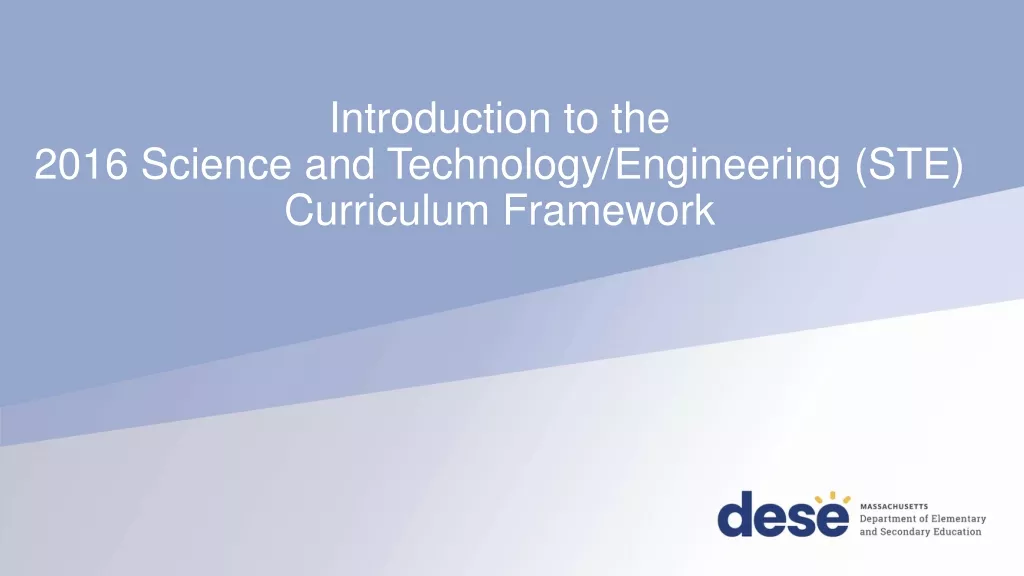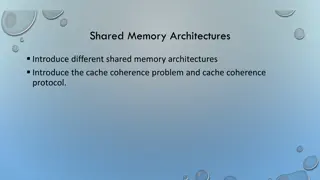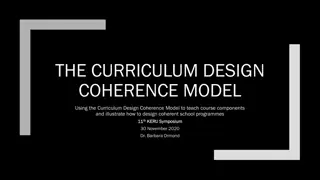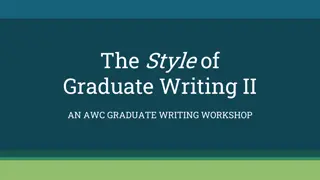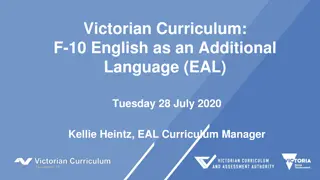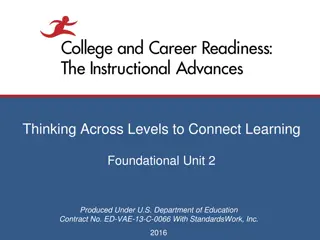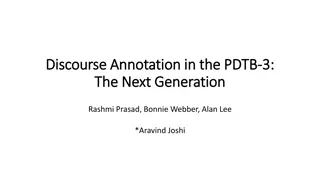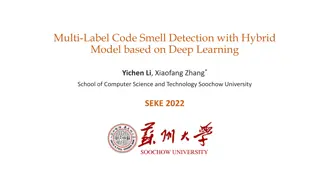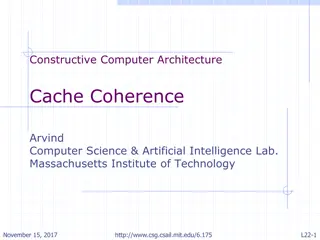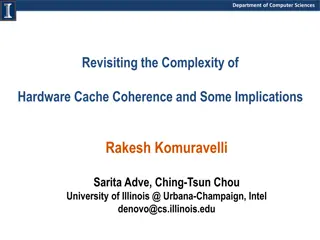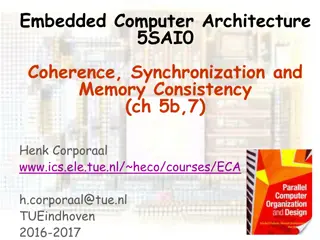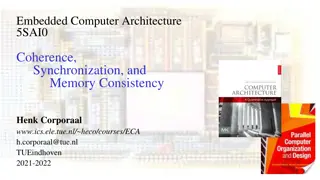Enhancing Curriculum Coherence for Deep Learning: A Model-driven Approach
Addressing the disconnect between conceptual knowledge and applied competencies in education, the Curriculum Design Coherence Model offers a structured framework to create coherence for deep learning. Developed in response to educational challenges such as skills versus knowledge imbalance and fragmented curricular content, the model emphasizes surfacing epistemic structure, integrating subject concepts, and bridging knowledge and application. Implemented in schools in New Zealand, it aims to guide teachers in designing curriculum that fosters comprehensive understanding and skill development.
Download Presentation

Please find below an Image/Link to download the presentation.
The content on the website is provided AS IS for your information and personal use only. It may not be sold, licensed, or shared on other websites without obtaining consent from the author.If you encounter any issues during the download, it is possible that the publisher has removed the file from their server.
You are allowed to download the files provided on this website for personal or commercial use, subject to the condition that they are used lawfully. All files are the property of their respective owners.
The content on the website is provided AS IS for your information and personal use only. It may not be sold, licensed, or shared on other websites without obtaining consent from the author.
E N D
Presentation Transcript
A Curriculum Design Project applying a model to create coherence for deep learning Dr Graham McPhail, Dr Barbara Ormond, Sally Tibbles, and Mary Cornish. CURRPD SEMINAR JUNE 15 2021
overview of the presentation Context what s the problem that needs solving? Theory The Curriculum Design Coherence Model (Rata, 2019) An example Chant for Year 7 Music
where did we see the problem? the initial version of the Curriculm Design Coherence (CDC) model emerged from an empirical study Engineering Course Design and Student Achievement funded by the Vice Chancellor s Strategic Development Fund (2016-2017) undertaken by researchers fom the Faculties of Engineering and Education and Social Work including Bill Collis, Graham McPhail, and Elizabeth Rata. students could pass exams using formula leaving them unable to generalize to other contexts a disconnect between conceptual knowledge and applied knowledge i.e. using one to inform the other knowing why students often lacked the specific language needed to discuss concepts. the CDC Model is a theoretical response to this problem of the disconnect between knowledge (knowledge-that) and competencies (know-how-to) and the ability to generalize from concepts which is common to many subject areas.
what wider/deeper educational problems is the model responding to? a skills versus knowledge bifurcation a know-how-to dominated curriculum in Aotearoa/NZ fragmented curricular content without conceptual integration and coherence the knowledge blind-spot an over-emphasis on pedagogy at the expense of what is taught the move to genericism and interdisciplinarity curricular and assessment autonomy in NZ
the Knowledge-Rich School Project a Curriculum Design Coherence (CDC)model is being developed within the KERU unit in the Faculty http://www.education.auckland.ac.nz/en/about/research/research-at-faculty/research-groups/keru/Keru-about.html it is in its fourth year of trial in six of schools both primary and secondary. What is the model, what does it do? The model assists teachers in the coherent design of curricula. It does this by providing four sequenced elements that require a teacher to first differentiate and then to connect concepts, content, and competencies, and then evaluate them. This coherence is generated by three interrelated design dimensions: (i) the surfacing of epistemic structure, (ii) the use of subject concepts, and (iii) the interrelationship between knowledge-that (knowledge of something) and know-how-to (knowing how to do something with that knowledge of something).
curriculum issues in History education Value of the Model: curricula autonomy in New Zealand Teachers of History have complete autonomy to select the history they teach. It is an incredibly high trust model that we ve presented to teachers. I understand how it sits within the philosophy of The New Zealand Curriculum to allow schools to evolve their own local prescriptions and curriculum, and that is admirable in terms of responding to student voice and learners in front of you, but even for a fairly confident reasonably sized department like ours where we can discuss and develop ideas together, it is still a huge challenge to create our own curriculum and justify the choices that we make. (Research participant) Problem - skills versus knowledge bifurcation History achievement standards signal that skills and procedures for investigating history are the most critical and can be shown independently of the knowledge learned by students
the problems in History education Problem - fragmented curricular content without conceptual integration and coherence Fragmented through: narrowing the focus of learning to the specifics needed to address the NCEA standards, So it s creating, of course, all hateful things of rote learning and preparing and redrafting one essay throughout an entire year. So it s narrowing the focus and you can talk all you like about teachers, it s in the teachers hands, but it s not actually, it s the framework that we operate within. (Research participant) Also fragmented through: being selective of which standards are taught which leaves out important learning and reduces coherence.
problem of knowledge in history knowledge is fragmented due to the segmented nature of the achievement standards for the NCEA Knowledge Critical Knowledge Fit knowledge is marginalised in teachers conceptions which has implications for curricula coherence Knowledge Engagement
theoretical grounding The model itself is underpinned by justified theories derived from and developed by Elizabeth Rata (2019): epistemology (Kant, Ryle, 1946; Winch, 2017), sociology (Durkheim, 1998; Bernstein, 2000), psychology (Vygotsky, 1986), cognitive science (Sweller, van Merri nboer, & Paas, 2019), and evolutionary psychology (Geary & Berch, 2016).
key theoretical points disciplinary-derived subject knowledge has a conceptual/epistemic structure. This structure provides affordances for learning disciplinary-derived subject knowledge comprises two knowledge forms - knowledge-that and know how-to (concepts/competencies) which in the model are first differentiated and then connected. knowledge--that comprises concepts and content which are differentiated and then connected deep learning is understanding the parts and whole (epistemic structure) of a topic and utilising the relationship between theoretical and applied knowledge (knowledge-that and know how-to) by being able to put conceptual knowledge to use in new contexts there is a relationship between the type and forms of knowledge students come into contact with and the development of cognitive architecture
what key propositions is the model responding to? That expertise/deep learning comes from an integration of two forms of academic knowledge propositional (knowledge-that) and applied (know-how-to). That deep learning first requires deep design - the conceptual structure of a topic to be clarified and mapped by the teacher (for the teacher) That curriculum design needs to acknowledge, accommodate, and make explicit the interdependent relationship (connections and distinctions) between conceptual knowledge (concepts and content) and techniques, skills). applied knowledge (competencies, The connection between the two forms of knowledge occurs in the ability to make judgements and to act on those judgements (Winch, 2017, p. 44). The starting place for design is concepts because they reveal the epistemic structure of a topic/area of study. Epistemic structure and its inferential relationships of concepts then has significant implications for pedagogy, particularly sequencing.
possible outcomes greater design and learning coherence increased understanding for teachers and students of how concepts inform the various levels of competencies which comprise know-how-to more visibility of assessment for learning in making judgements the development of a student s academic identity
the model The CDC model proposes that deep learning requires design coherence that precedes pedagogy. This coherence is generated by three interrelated design dimensions: (i) the surfacing of epistemic structure, (ii) the use of subject concepts that is connected to content (iii) the bringing together of knowledge-that (knowledge of something) and know-how-to (knowing how to do something with that knowledge of something).
Element 1: Select and sequence subject concepts from a subject topic proposition The course designer begins by deciding on the subject topic, course, or programme to be designed and then creates a concept map of superordinate (key) and subordinate (related) concepts eventually devising a proposition that states what the topic, course or programme is about. Select concepts Key and related concepts Decide on the topic Write a proposition The process of developing the proposition statement includes identifying the key subject concepts in accordance with the epistemic/conceptual structure of the topic. The role of the proposition statement to connect the topic to the main subject concepts thereby beginning the process of design coherence.
examples of key and related concepts Assessment Select the key subject concept(s) of the proposition Human Rights Fairness Related subject concepts 1. Concepts connected to the nature and enactment of Human Rights: universal, inalienable, violation, International Law 2. Concepts showing what Human Rights offer: human dignity, freedom, social justice 3. Concepts showing what Human Rights protect against: persecution, exploitation, oppression, unjust discrimination, modern slavery Consistency Transparency Concepts of Assessment Validity Manageability
examples of propositions Note: Red font identifies the subject concepts Social Sciences example The Universal Declaration of Human Rights 1948 is a document which upholds the principles of social justice and human dignity and states the intention of contributing nations to protect the rights of their citizens regardless of peoples ethnicity, religion, beliefs, sex, language, or other status. Music example A chord progression is a sequence of chords that creates musical meaning through expected and unexpected use of harmonic logic, chord juxtapositions, and harmonic rhythm. Teacher education example Fair and valid assessment is well aligned to learning, assesses important knowledge and skills, and enables sound assessor judgments to be made.
Element 2: connect generalising topic concepts to subject content This element connects the subject concepts in the epistemic structure identified in Element One to the course content. The combination of the subject concepts and the subject content is Knowledge-that . Subject concepts Content This element indicates the key distinction that the model makes between subject concepts and subject content. The difference is that subject concepts are generalisable and can apply to varied content while content is specific. There are three justifying criteria for choosing the content: the most apposite content (epistemic) content that in some way shows the development of the concept (socio-epistemic) content that may be socio-politically important (socio-political)
examples of Element 2 connecting subject concepts to content Assessment Human Rights Validity refers to the relationship between what is required to be assessed (e.g. adhering to a prescription, or mandated outcomes), and the matters being assessed in the assessment tasks. These need to be aligned. Pre-service teachers will be shown how, for example, NCEA assessments align with the requirements of the Achievement Standards. Validity should also be a fundamental principle when considering what knowledge or skills are suitable and worthwhile to assess. The universality of Human rights: Human Rights are universal because they apply to all citizens of United Nations member states and are protected through International Human Rights Law. The United Nations has established mechanisms to promote and protect these rights and to assist nations in carrying out their responsibilities.
Element 3: connect knowledge-that to know-how-to Element 3 indicates the pivotal relationship between knowledge- that and know-how-to. The subject competencies, techniques, and skills to be designed and taught are those which connect the epistemically structured subject concepts to the material world by providing practice in applying the subject concepts and using the subject s content. The model proposes a focus on two key competencies that aim to highlight the connection between knowledge-that and know- how-to: performance competencies and judgement competencies.
Know Know- - how how- -to examples of Element 3 connect knowledge-that to know-how-to to Human Rights Assessment Performance competencies I know-how-to design an assessment which is fair, valid and manageable. Performance competencies I know-how-to recognise bias and differing perspectives in relation to verbal, textual and visual expressions of Human Rights violations. I know-how-to manage assessment in a way which is transparent for the learners. I know-how-to research societies who have been affected by persecution, exploitation, oppression, unjust discrimination etc. and how to relate these situations to the articles in The Universal Declaration of Human Rights. I know-how-to assess student work fairly using a standards- based schedule and how to ensure consistency in grades. Judgement competencies I know-how-to critique assessments to see if they are fair, valid, transparent and manageable for the learner. Judgement competencies I know-how-to recognise violations of The Universal Declaration of Human Rights. I know-how-to analyse assessment tasks to see if they align well with the skills or knowledge that has been taught and with the Achievement Standard they are being assessed against. I know-how-to evaluate some of the impacts on individuals and societies when Human Rights are breached and explain how these situations breach articles in The Universal Declaration of Human Rights.
Element 4: evaluating knowledge-that and know- how-to The proposition guides what will be evaluated The purpose of evaluation is to measure the level of mastery achieved by establishing the degree of understanding students demonstrate between their know-how-to and knowledge-that. In this Element three competencies are assessed 1. recall 2. skill and technique 3. intelligent know-how-to
examples of Element 4 evaluating knowledge-that and know-how-to Human Rights Example Content recall - Students would need to recall: The intent of, and key ideas contained in, The Universal Declaration of Human Rights. The meanings of the subject concepts in the context of Human Rights. Skill and technique -Students would need be able to demonstrate: Analytical skills when dealing with evidence: primary and secondary sources statistical, visual, textual. An awareness of differing viewpoints, cultural attitudes, and potential biases when evaluating whether or not specific actions uphold or breach Human Rights. Intelligent Know-how-to - Students would need be able to demonstrate understanding of: The implications of International Human Rights Law and appropriately selected case studies. The importance of bias and of differing perspectives when evaluating the social issues associated with Human Rights.
an exemplar Sally Tibbles and Mary Cornish on Chant
Summary: three mechanisms for deep coherence and deep leaning 1: Deep coherence is achieved by aligning curriculum design with the epistemic structure of the knowledge to be learnt. Curriculum design comes before pedagogy because what the knowledge actually is determines how best to teach it. 2: Deep coherence is achieved by linking content and competencies explicitly to generalising subject concepts. 3: Deep coherence is achieved through the interdependence of knowledge-that and know-how-to. 4: epistemically structured knowledge provided unique affordances for the development of students cognitive architecture.
the key proposition Deep learning and expertise are developed from the coherence provided by (i) making the epistemic structure of what is to be learnt and (ii)the interrelationship between knowledge-that (concepts and content) and know-how-to (applied knowledge/competencies) the basis of design.
references Geary, D. & Berch, D. (2016) Evolution and children s cognitive and academic development. In D. C. Geary & D. B. Berch (Eds.), Evolutionary perspectives on child development and education, evolutionary psychology (pp. 217 249). Switzerland: Springer International Publishing. McPhail, doi:10.1080/00220272.2020.1748231 G. (2020) The search for deep learning: a curriculum coherence model. Journal of Curriculum Studies. Rata, E., & McPhail, G. (2020) Teacher Professional Development, the Knowledge-Rich School Project and the Curriculum Design Coherence Model. In J. Fox, C. Alexander, & T. Aspland (Eds.), Teacher Education in Globalised Times: Local Responses in Action (pp. 311-329). Singapore: Springer. doi:10.1007/978-981-15-4124-7_17 Rata, E. (2019) Knowledge rich teaching: A model of curriculum design coherence. British Educational Research Journal, 45(4), 681-697. Rata, E. (2021) The Curriculum Design Coherence Model in the Knowledge-Rich School Project, Review of Education, https://bera- journals.onlinelibrary.wiley.com/doi/full/10.1002/rev3.3254 Ryle, G. (1949). Knowing how and knowing that. Proceedings of the Aristotelian Society, 56, 212-225. Sweller, John (2016). Cognitive load theory, evolutionary educational psychology, and instructional design. In D. C. Geary & D. B. Berch (Eds.), Evolutionary perspectives on child development and education, evolutionary psychology (pp. 291 306). Switzerland: Springer International Publishing. Winch, C. (2017). Teachers know-how: A philosophical investigation. Wiley Blackwell.



